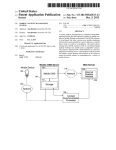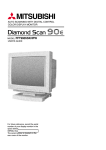Download System and method for reconfiguration of an entertainment system
Transcript
US 20140366059A1 (19) United States (12) Patent Application Publication (10) Pub. N0.: US 2014/0366059 A1 (43) Pub. Date: Dec. 11, 2014 Arling et al. (54) SYSTEM AND METHOD FOR continuation-in-part of application No. 12/569,121, RECONFIGURATION OF AN ?led on Sep. 29, 2009, noW Pat. No. 8,243,207. ENTERTAINMENT SYSTEM CONTROLLING _ DEVICE _ _ _ Publication Classi?cation (71) Applicant: UNIVERSAL ELECTRONICS INC., (51) Int- Cl Sama Ana CA (Us) H04N 21/422 (2006.01) ’ H04N 21/482 (2006.01) (72) Inventors: Paul D. Arling, Irvine, CA (US); (52) U-s- Cl Patrick (Us) HI Hayes, Mission Viejos ..... .. USPC (2013.01) .......................................................... .. 725/38 (73) Assignee: Universal Electronics Inc. (57) (21) Appl_ No; 14/469,071 (22) Filed_ An entertainment device is used to notify a user of a change in an audio visual entertainment system con?guration in Which at least one of a plurality devices is connected to the enter ' Aug 26 2014 l ’ tainment device as an audio and/or visual source and at least . . one of the plurality of devices is connected to the entertain Related U's' Apphcatlon Data (63) ABSTRACT ment device as an audio and/ or visual output destination for Continuation of application No. 13/785,015, ?led on Mar. 5, 2013, now Pat. No. 8,830,074, Which is a continuation of application No. 12/621,277, ?led on Nov. 18, 2009, now Pat. No. 8,456,314, Which is a the entertainment device and/or to notify a user of a perceived problem in a con?guration of a controlling device used to control functional operations of the audio visual entertain ment system. Actiwty button activated Actwtty con?gured 7 f 630 602 Y 604 WATCH MOVIE Please select source Prompt user to first set up actnnty Ailow user l0 choose deswed Souroe device A Y to move 4 > to include “SEL” when done Press ‘EXiT to quit 608 ou rce powered on2 610 Request remote to power on source f 632 device \ 612 WATCH MOVIE 614 Ailow user to Select desired Please select destination - l'OjeC Of destination devioe A Y to move 4 > to inciude “SEL” when done Press'EXiT m unt Request remote to power on (test device Patent Application Publication Dec. 11, 2014 Sheet 1 0f8 — a mm = ll... = 9 — = W .0... B 5 IQ I 130 US 2014/0366059 A1 Patent Application Publication \ Dec. 11, 2014 Sheet 2 0f 8 \ Play Activit Activity game one two US 2014/0366059 A1 / / \ \ \ Volume _ _ Channel \ 204 /@ “>\.\(220 \0 [l1] III," ___-' (EDGE) CJCDCD CDCDCD CDCDCD CDCJC) 100 Figure 2 Patent Application Publication Dec. 11, 2014 Sheet 3 0f8 US 2014/0366059 A1 300 / [-310 31 6 \- Key matrix Transmitter 0r transceiver circuit 302 h 306 0 w \ User feedback 8 device 0 2 O. memory O 8 318 L E E Input/Output | Clock and III timer logic foetal-I‘— 314 / 304 ROM 2 memory RAM memory I + 312 Figure 3 K 305 Patent Application Publication Dec. 11, 2014 Sheet 4 0f 8 US 2014/0366059 A1 f 408 420a, 420b, 4200 KI r 406 Audio Audio inputs processing 430a, 430b él Audio ouputs /' 410 422a, 422b, 4220 402 \ K AV inputs Front panel ROM _ h RAM _ NV B8 :5 8 RIG 8 § interface _ f 412 Q. RAM f- 414 Network [400 connection | /- 404 424a, 424b, 4240 \ I; '1 4343, 434b Video processing Video inputs Video oupUtS ? Figure 4 Patent Application Publication Dec. 11, 2014 Sheet 5 0f 8 53c US 2014/0366059 A1 WELCOME TO ACTIVITY SET UP User activates desired activity button Please select an activity _\ l button on your remote control. 502 Display POSSibIE Press “EXlT‘ to quit inputs (source devices) for activity \ l 504 532 k WATCH MOVIE SETUP Allow userto Step 1: Select source select one Or more source devices ‘\ I: \ l /" 506 Dispiay Possibie 536 outputs BIEQ/iga Game <‘lié°in”é?u“§e “SEL” when done (desunation Press “EXlT‘ to quit devices ) for activity ii 508 Allow user to 538 \ select one or more WATCH MOVIE SETUP Step 2_ Select destination -' devices - destination \ + EEI 510 -> Proiector A Y to move _ _ _ 4 > to include Configure actiVity “SEL” when done parameters \ l Press “EXlT‘ to quit 512 Display completion 540 message (with \ rem'mjer 'f mu't'p'e CONGRATULATIONS! “Watch Movie" activity setup is complete. SOUI'CES OF destinations) _ _ .0,— Because you configured multiple ¢ 514 / 542 sources, you will be prompted each time to select which one to use. Y More to semi)? To set up another activity, select the activity button on your remote. Else press "EXIT" if done. 516 Press‘EXIT to quit Figure 5 Patent Application Publication Dec. 11, 2014 Sheet 6 0f 8 US 2014/0366059 A1 Activity button activated Activity configured? f 630 624 \ WATCH MOVIE V Please select source . Allow user to prompt user? ?rst choose desired 5m up aCt'V'ty source device = U9 4}! \ ay move 4AbY toto include “SEL” when done Select input Press “EXtT” to qutl \ 608 ource powered on’? Request remote to power on Source - device f 632 WATCH MOVIE Please select destination Allow user to select desired I rojector destination deVIce A Y to move 4 > to include “SEL” when clone Press ‘EXtT” to quit Request remote to power on dest. device 4% \620 Send con?guration data to remote \ 622 Figure 6 Patent Application Publication Dec. 11, 2014 Sheet 7 0f8 US 2014/0366059 A1 own vow wwh 25EN NPN wowN00% 10:5 , wrw own own Patent Application Publication Dec. 11, 2014 Sheet 8 0f 8 US 2014/0366059 A1 DEVICE CHANGED The device connected to input “DVD” has changed. Your remote control set up 802\ 804 may need to be updated. T Set up remote now 806 Remind me later __/ Don’t show this message aga|n " to move SEL to select EXIT to quit \ Figure 8 DEVICE PROBLEM? IT APPEARS THAT YOUR DVD PLAYER IS NOT RESPONDING AS EXPECTED. SUGGESTIONS: - Is your remote in “DVD” mode? v - Is there an object between you and the player? Does your remote need to be set up? EXIT to quit Figure 9 \ Dec. 11, 2014 US 2014/0366059 A1 SYSTEM AND METHOD FOR RECONFIGURATION OF AN ENTERTAINMENT SYSTEM CONTROLLING DEVICE RELATED APPLICATION DATA [0001] This application claims the bene?t of and is a con tinuation of US. application Ser. No. 13/785,015, ?led on Mar. 5, 2013, which application claims the bene?t of and is a continuation ofU.S. application Ser. No. 12/621,277, ?led on Nov. 18, 2009, which application claims the bene?t of and is a continuation-in-part of US. application Ser. No. 12/569, 121, ?led Sep. 29, 2009, the disclosures of which are incor since prior art initial user set up of AV receivers is generally GUI based and includes assignment of user-friendly names to source and destination appliances (for example, “DVD” in place of “Video input 3”), a user’s initial speci?cation of desired activity con?gurations may be facilitated by the use of these features when con?guring activities. [0004] A better understanding of the objects, advantages, features, properties and relationships of the invention will be obtained from the following detailed description and accom panying drawings which set forth illustrative embodiments and which are indicative of the various ways in which the principles of the invention may be employed. BRIEF DESCRIPTION OF THE DRAWINGS porated herein by reference in the entirety. BACKGROUND [0002] Home entertainment systems in which multiple media sources and multiple media rendering devices are coupled through a central routing device such as an AV receiver are well known in the art, as are universal controlling devices adaptable to issue commands to a multiplicity of appliances of different manufacture and/or type and which are frequently associated with such home entertainment sys tems. As these home entertainment systems become increas ingly complex due to the proliferation of media formats, appliance types, etc., the user actions required to con?gure a home entertainment system to match a desired activity such as watching TV or listening to music have become increasing [0005] For a better understanding of the various aspects of the invention, reference may be had to preferred embodi ments shown in the attached drawings in which: [0006] FIG. 1 illustrates an exemplary system in which the methods of the instant invention may be practiced; [0007] FIG. 2 further illustrates an exemplary controlling device of the system of FIG. 1; [0008] FIG. 3 illustrates a block diagram of exemplary components of the exemplary controlling device of FIG. 2; [0009] FIG. 4 illustrates a block diagram of exemplary components of an AV receiver of the system of FIG. 1; [0010] FIG. 5 illustrates an exemplary activity con?gura tion setup process in accordance with the methods of this invention; onerous and error prone. Various methods have been pro [0011] posed for automating all or part of these con?guration opera tions, for example through use of controlling device based process in accordance with the methods of this invention; [0012] FIG. 7 illustrates a second exemplary activity con ?guration setup process in accordance with the methods of macro sequences such as described in US. Pat. No. 5,959,751 or state-based control such as described in US. Pat. 6,784, FIG. 6 illustrates an exemplary activity switching this invention; 805. However, such methods may themselves be subject to [0013] error when equipment con?gurations or connections are not user to recon?gure a controlling device upon changing an as expected, leading only to further user frustration. appliance to be controlled; and [0014] FIG. 9 illustrates exemplary help information which SUMMARY OF THE INVENTION [0003] This invention relates generally to improved meth ods for con?guring a multi-input and/or multi-output home FIG. 8 illustrates an exemplary display prompting a may be presented to a user when it is detected that an appli ance is not responding correctly to command requests. DETAILED DESCRIPTION entertainment system to match a user’s desired activities. In such systems, the outputs and inputs of the various compo [0015] nents are generally routed to and switched through one cen tral device such as an AV receiver. The inventive methods plary home entertainment system in which the audio/video described herein comprise a cooperative effort between the AV receiver and an associated universal controlling device for example a set top box (“STB”) 104, a ?rst DVD player 106, a second DVD player 108, a game console 110, anda CD such as a remote control in which activation of an activity key or button on the controlling device results in transmission of a signal to the AV receiver to initiate certain previously changer 112 are all connected as inputs to anAV receiver 102. AV receiver 102 in turn functions to switch the currently de?ned con?guration actions, which actions may be condi tioned upon the AV receiver’s determination of the current Turning now to FIG. 1, there is illustrated an exem outputs of a group of various media source appliances such as desired input media stream to one or more designated outputs of AV receiver 102 which are, in turn, connected to various audio and/or video rendering devices such as TV 114, pro status of connected devices. In addition, certain controlling device command transmissions to other appliances in the jector 118, and/or loudspeakers 116; all as is well known in home entertainment system may also be initiated as a result of include a network interface 120, for example Ethernet, for the routing of streaming media input/output from or to other said activity key activation, either unilaterally by the control ling device or at the request of the AV receiver. Since the AV receiver has access to appliance status information not avail able to the controlling device (by virtue of the AV receiver’s physical connection to those appliances), and the controlling device in turn has access to appliance command functions not available to the AV receiver, the cooperative execution of an activity con?guration request in this manner may result in more reliable and user-friendly system operation. In addition, the art. In some embodiments AV receiver 102 may also areas of the home. When included, such a network interface may also be available for Internet access, download of ?rm ware updates and/or other data into AV receiver 102, etc., again as well known in the art. Also illustrated is a universal controlling device 100 which is capable of transmitting com mands to the appliances, using any convenient IR, RF, Point to-Point, or networked protocol, to cause the appliances to perform operational functions. While illustrated in the con US 2014/0366059 A1 text of a home entertainment system, it is to be understood Dec.11, 2014 tively), and/or may be physically incorporated within the that appliances controllable by universal controlling device same IC chip as the microprocessor 300 (a so called “micro 100 may include, but need not be limited to, televisions, VCRs, DVRs, DVD players, cable or satellite converter set controller”) and, as such, they are shown separately in FIG. 3 only for the sake of clarity. top boxes (“STBs”), ampli?ers, AV receivers, CD players, game consoles, home lighting, drapery, fans, HVAC systems, action, the controlling device 100 is adapted to be responsive [0018] To cause the controlling device 100 to perform an thermostats, personal computers, etc. In a preferred embodi ment, controlling device 100 supports bidirectional commu to events, such as a sensed user interaction with the key matrix nication 130 with AV receiver 102 via any convenient IR or within the program memory (hereafter the “controlling device operating program”) may be executed. For example, RF protocol. In an exemplary embodiment, controlling device 100 may be further adapted to function in cooperation with AV receiver 102 to con?gure the illustrative entertain ment system in accordance with a user’s desired activities. To this end, as illustrated in FIG. 2, an exemplary controlling device may be provisioned with a series of activity selection keys or buttons 200 with designations such as, for example, “Watch TV”, “Watch a Movie”, “Listen to Music”, “Play a Game”, etc. Activation of such an activity selection key may causeAV receiver 102 and/or controlling device 100 to coop eratively place the exemplary home entertainment system into a user-speci?ed state which has been associated with that activity, as will be described in further detail hereafter. 316, etc. In response to an event, appropriate instructions when a function key is actuated on the controlling device 100, the controlling device 100 may retrieve from the command data stored in memory 304, 305, 306 a command value and control protocol corresponding to the actuated function key and, where necessary, current device mode and transmit that command to an intended target appliance, e.g., STE 104, in a format recognizable by that appliance to thereby control one or more functional operations of that appliance. It will be appreciated that the operating program can be used not only to cause the transmission of commands and/ or data to the appli ances, but also to perform local operations. While not limit ing, local operations that may be performed by the controlling functional operations of one or more appliances, the control device 100 may include displaying information/data, favorite channel setup, macro key setup, function key relocation, etc. ling device 100 may include, as needed for a particular appli Examples of local operations can be found in US. Pat. Nos. cation, a processor 300 coupled to a ROM memory 304, a 5,481,256, 5,959,751, and 6,014,092. RAM memory 305, a key matrix 316 (e.g., hard keys, soft [0019] For selecting sets of command data to be associated with the appliances to be controlled data may be provided to controlling device 100 that serves to identify each intended [0016] Turning now to FIG. 3, for use in commanding the keys such as a touch sensitive surface overlaid on a liquid crystal (LCD), and/or an electroluminescent (EL) display), transmission circuit(s) and/or transceiver circuit(s) 310 (e.g., IR and/or RF), a non-volatile read/write memory 306, a means 302 to provide feedback to the user (e.g., one or more LEDs, display, speaker, and/or the like), an input/output port 318 such as a serial interface, USB port, modem, Zigbee, WiFi, or Bluetooth transceiver, etc ., and clock and timer logic target appliance by its make, and/or model, and/or type. Such data allows the controlling device 100 to identify the appro priate command data set within a library of command data that is to be used to transmit recognizable commands in formats appropriate for such identi?ed appliances. Such a 312 with associated crystal or resonator 314. library of command data may be preprogrammed in control ling device 100, downloaded into controlling device 100 as [0017] As will be understood by those skilled in the art, part of the setup process, or a combination thereof. The some or all of the memories 304, 305, 306 may include library of command data may represent a plurality of control lable appliances of different types and manufacture, a plural ity of controllable appliances of the same type but different executable instructions (collectively, the controlling device program memory) that are intended to be executed by the processor 300 to control the operation of the remote control 100, as well as data which serves to de?ne to the operational software the necessary control protocols and command val ues for use in transmitting command signals to controllable appliances (collectively, the command data). In this manner, manufacture, a plurality of appliances of the same manufac ture but different type or model, etc., or any combination thereof as appropriate for a given embodiment. In certain embodiments, such data used to identify an appropriate com mand data set may take the form of a numeric setup code the processor 300 may be programmed to control the various electronic components within the remote control 100, e.g., to monitor the key matrix 316, to cause the transmission of signals, etc. The non-volatile read/write memory 306, for (obtained, for example, from a printed list of manufacturer names and/or models with corresponding code numbers, from a support Web site, etc.) which may be entered via example an EEPROM, battery-backed up RAM, FLASH, mission of commands to an appliance, preferably the keys Smart Card, memory stick, or the like, may additionally be that are labeled with numerals. provided to store setup data and parameters as necessary. [0020] Alternative device setup procedures known in the art include scanning bar codes, RFID tags, or other indicia; sequentially transmitting a predetermined command in dif ferent formats until a target appliance response is detected; interaction with a Web site culminating in downloading of command data and/or setup codes to the controlling device, etc. Further, in embodiments such as that illustrated in FIG. 1, set up of a controlling device 100 may be performed interac tively in conjunction withAV receiver 102, using a connected While the memory 304 is illustrated and described as a ROM memory, memory 304 can also be comprised of any type of readable media, such as ROM, FLASH, EEPROM, or the like. Preferably, the memories 304 and 305 are non-volatile or battery-backed such that data is not required to be reloaded after battery changes. In addition, the memories 304, 305 and 306 may take the form of a chip, a hard disk, a magnetic disk, an optical disk, and/or the like. Still further, it will be appre ciated that some or all of the illustrated memory devices may activation of those keys that are also used to cause the trans device such as TV 114 for GUI display and a database of codes and/or brand and model information stored locally on be physically combined (for example, a single FLASH memory may be logically partitioned into different portions AV receiver 102 or located remotely on a PC or Web server to support the functionality of memories 304 and 306 respec and accessed via network connection 120. Since such meth US 2014/0366059 A1 ods for setting up a controlling device to command the opera tion of speci?c home appliances are well-known, these will not be described in greater detail herein. Nevertheless, for additional information pertaining to setup procedures, the reader may turn, for example, to US. Pat. Nos. 4,959,810, 5,614,906, or 6,225,938 or to pending US. patent application Ser. No. 11/915,562, all of like assignee and all incorporated herein by reference in their entirety. [0021] With reference to FIG. 4, an exemplary AV receiver 102 may include, as needed for a particular application, a control processor 400 coupled to a memory 402 which may comprise any combination of ROM, RAM, and/ or non-vola tile read write memory; video and audio processing sections 404, 406; a tuner 408 for reception of radio broadcast chan nels; a front panel 410 including user controls and/or a dis play; a remote control interface 412 for communicating with a controlling device (e.g. 100); a network interface 414 for communication with a local and/ or wide area network; audio inputs 42011 through 4200; [0022] video inputs 42411 through 4240; AV inputs 42211 through 4220; audio outputs 430a, 4301); and video outputs 434a and 43419. As will be appreciated, audio and video inputs and outputs (which may be more or less in number than illustrated) may comprise analog or digital signals and exem plary AV receiver 102 may be provisioned with analog-to Dec.11, 2014 tionality the interested reader may reference, for example, a document such as the Denon AV Surround Receiver STR DA5500ES Owner’s Manual (D&M Holdings Inc. publica tion number 5411 10255 000D). [0025] In addition, in an exemplary embodiment described herein the AV receiver operating program may include pro gramming which functions in cooperation with controlling device 100 to de?ne and subsequently execute user-desired con?guration of the home entertainment system in accor dance with various activities. [0026] With reference to FIG. 5, after completing the initial set up of AV receiver 102, for example as described in the above referenced Denon STR-DA5500ES User’s Manual, a user may wish to con?gure the functionality of the activity buttons 200 of controlling device 100. To this end, she may place the AV receiver into an activity setup mode via, for example by a sequence of keypresses on controlling device 100, use of navigation keys 210 of controlling device 100 to select a menu item displayed on TV 114, or such other action as may be appropriate for a particular embodiment. Upon entering activity setup mode, the AV receiver operating pro gram may display an exemplary initial status message 530 on TV 114 prompting the user to select an activity to con?gure. digital (ADC) converters, digital-to-analog (DAC) convert The AV receiver operating program thereafter waits at step 502 for user input, i.e. activation of one of the activity buttons 200 of controlling device 100. In the illustrated example, the ers, video decoders, HDMI encoder/ decoders, CODECs, user may select button 202 labeled “Watch a Movie”, result format converters, etc., all as necessary to implement the ing in communication by the controlling device 100 of an input/output switching and routing functionality. It will be appropriate key command value to AV receiver 102. Upon further appreciated that the functionality of video and audio processing blocks 404 and 408 may be implemented in sepa rate components such as a specialized digital signal proces receipt of the “Watch a Movie” activity command, at step 504 the AV receiver operating program may display a listing 532 sors (DSP), may be implemented as part of control processor 400, or any combination thereof, and that portions of memory inputs 422, 424 of AV receiver 102. In this context it will be appreciated that the earlier-mentioned initial setup proce dures of AV receiver may include user labeling/ identi?cation of the devices connected to the various inputs together with a selection of compatible command data sets within universal 402 may be allocated to or associated with audio and video processing blocks 404,408. of available source devices that are known to be connected to [0023] It will also be appreciated that some or all of the memory elements 402 may take the form of a chip, a hard controlling device 100, and the resulting user friendly labels disk, a magnetic disk, an optical disk, FLASH memory, and/ such as “DVD player”, “Projector”, etc. may be used there after in the generation of displays such as that illustrated at or the like, and that all or portion of the memory 402 may be physically incorporated within the same IC chip as the control processor 400 and/or audio or video processing blocks 404, 406 and, as such, memory 402 is shown separately in FIG. 4 only for the sake of clarity. [0024] As will be understood by those skilled in the art, some or all of the memory 402 may include executable instructions that are intended to be executed by the processor 532. Additionally, the displayed listing may be further tai lored by the AV receiver operating program to include only those currently-con?gured devices known to be compatible with the speci?ed activityifor example, for the presently illustrated “Watch a Movie” activity devices which are inca pable of sourcing a video stream, such as CD player 112 or tuner 408 may be omitted from the list presented to the user. 400 to control the operation of the AV receiver 102 (hereafter, the “AV receiver operating program”). In this manner, the processor 400 may be programmed to control the various electronic components within the AV receiver, e.g., to moni At step 506, the user may employ navigation keys 210 of tor the front panel 410 and or remote control interface 412, to more than one source device is designated, the user may be cause the routing of video and/or audio signals between the various inputs and outputs, to control selection of radio broadcast channel by tuner 408, to control volume and equal ization settings of audio outputs 430a and 430b, etc. Further, the AV receiver operating program, in conjunction with video processing block 404, may provide GUI-based setup menus for AV receiver functions such as input and output assign ments, levels, balances, equalization, etc., via a connected video monitor device such as for example TV 114. Since such GUI-based AV receiver setup is well known in the art, for the sake of brevity it will not be described further herein, however if greater detail is desired regarding such features and func prompted at activity execution time to select the desired controlling device 100 to move a cursor 536 and select desired source device(s). One or more source devices may be selected, as indicated for example by indicia 534. In the event source, as will be described in further detail hereafter in conjunction with FIG. 6. [0027] Upon completion of source device selection, at step 508 a list 538 of possible destination devices may be dis played foruser selection at step 510 in a similar manner to that described above. Once again, the list of devices may be tai lored by the AV receiver operating program to include, in this case, only those currently-con?gured devices known to be capable of rendering the designated input media stream(s). Although not shown, it will be appreciated that other con?gu ration options may also be presented to the user in certain Dec. 11, 2014 US 2014/0366059 A1 embodiments, for example, selection of a destination for audio output. Once all user selections have been made, at step 512 the activity con?guration parameters may be ?nalized and stored in AV receiver memory 402 for future use in con?guring the home entertainment system when the indi cated activity is called for, e.g., the ?nal con?guration is stored and associated with the received key command value corresponding to the activity key that was activated at the start of the con?guration process. Thereafter, the AV receiver oper ating program may display a completion message 540, tain embodiments. If the selected destination device is not powered on, in a preferred embodiment at step 620 a request may be issued to controlling device 100 via bidirectional communication link 130 to transmit a “power on” command to the destination appliance. [0029] While initiation of a “Watch a Movie” activity via key 202 may result in automatic con?guration of keys of the controlling device, e.g., transport keys 240 may be con?gured to transmit commands in a format compatible with whichever of appliances 104, 106, 108 have been pre-con?gured as the including in this example a reminder 542 that ?nal source media source within the remote control when in the “Watch a selection will be required at execution time. At step 516, the Movie” activity mode, in the event that multiple possible user indicates whether she wishes to set up another activity, in which case processing returns to initial step 502. If not, activ ity setup is complete and the AV receiver operating program exits setup mode and returns to normal operation. [0028] The execution of an exemplary activity con?gura tion request will now be discussed in conjunction with FIG. 6. Upon actuation of an activity button on controlling device 100, for example 202 “Watch a Movie” and receipt of the resulting appropriate key command value communication by AV receiver 102, assuming the AV receiver operating pro gram is in the normal operation state (i.e. not in setup mode as described previously), at step 602 the AV receiver operating program ?rst determines if the activity by the key command value received from the controlling device has in fact been con?gured. If not, at step 624 an error message is displayed, for example on TV 114, prompting the user to ?rst con?gure that activity, and the activity request is ignored. If the activity sources (or destinations) are possible in the “Watch a Movie” activity mode (which does not allow for a pre-con?guration of the keys of the controlling device to a particular appliance), at step 622 data indicative of the appliances to be controlled in the currently selected activity mode may be transferred over bidirectional communication link 130 from the AV receiver operating program to controlling device 100 to cause the controlling device to con?gure itself to match the activity and selected source and destination appliances. It will also be appreciated that keys of the controlling device 100 may, in whole or inpart, be matched to an intended target appliance as a result of receipt of the aforementioned requests to power-on a device and, as such, step 622 can be skipped if this data has already been provided to the controlling device by the AV receiver. [0030] Although not illustrated in the example of FIG. 6, in certain embodiments additional appliance con?guration may has been con?gured, at step 604 the AV receiver operating program next determines from the con?guration associated with the received key command value if multiple sources be initiated by the AV receiver operating program and/or the controlling device operating program and performed by con trolling device 100, for example issuance of commands for were con?gured. If so, at step 606 the options are displayed as illustrated at 630 and the user is prompted to select a desired adjustment of video aspect ratio or picture settings to opti source device, for example, by using the navigation and selec tion keys of the controlling device to highlight and select the mize presentation of the selected source material, etc. Also, additional actions may be initiated by the AV receiver oper desired source device. As will be appreciated, if only one source device was con?gured at setup time, this step may be skipped. Once a source device has been designated, at step 608 the AV receiver operating program selects the audio, video and/orAV inputs associated with the designated source device. At step 610, the AV receiver operating program deter mines if the selected source device is powered on, for example by detecting presence or absence of audio/video signal, sensing HDMI status, etc. as appropriate for the device connection in question. Alternatives such as power sensing, etc. may also be available in certain embodiments. If the selected source device is not powered on, in a preferred embodiment at step 612 a request may issued to controlling device 100 via bidirectional communication link 130 to trans mit a “power on” command to the source appliance. As will be appreciated, such a request would include data that functions to indicate to the controlling device 100 the intended target appliance for the “power on” command. Thereafter, at step 614 the AV receiver operating program determines if multiple destinations were con?gured. If so, at step 616 the options are displayed as illustrated at 632 and the user prompted to select a desired destination device as described above. Again, if only one destination device was con?gured at setup time, this step selection of an appropriate input on TV 114 or projector 118, ating program and/or the controlling device operating pro gram with respect to appliances not participating in an activ ity. For example, initiation of a “Listen to Music” activity may cause the controlling device itself, or result in the issuance of requests to controlling device, to power off video display devices such as TV 114 or projector 118. [0031] In addition to the interactions with AV receiver 102 described above, in certain embodiments the activation of an activity selection button 200 may also invoke a conventional controlling device- based macro command sequence as is known in the art and described, for example, in the previously referenced U.S. Pat. No. 5,959,751. Such macro sequences may be programmed by a user to, for example, adjust lighting levels, control drapes, etc. to create an environment suitable for the commanded activity, as well as to perform additional entertainment appliance con?guration functions if desired. [0032] Turning now to FIG. 7, in an alternative embodi ment, a PC based activity setup application may be offered in place of or as an alternative to the AV receiver GUI based setup previously described above in conjunction with FIG. 5. Such a PC based setup option may comprise a locally installed application program, a Web application, or a com may be skipped. At step 618, the AV receiver operating pro gram determines if the selected destination device is powered on, for example by sensing HDMI status. Alternatives such as bination thereof. As illustrated in FIG. 7, the PC based setup application may comprise a GUI 700 which offers a series of drop-down menus 702, 704 from which the various con?gu ration options may be selected. In the illustrative example, detection of AV signals from an auxiliary output of a render ing device, power sensing, etc. may also be available in cer of sources and outputs of an activity and selection and assign separate panels 706 and 708 allow selection and con?guration US 2014/0366059 A1 Dec. 11, 2014 ment of appliance/ controlling device key functionality for that activity, respectively. As will be understood by those of upon detection of the change, may occur upon receipt of the skill in the art, in general two drop-down menus such as 710 and 716 may not be active the same time, they are however illustrated as such in FIG. 7 to assist in a better understanding deferred until the newly added or changed appliance is of the PC application. Drop down menu panel 706 may offer AV receiver related activity con?guration choices similar to those previously described in conjunction with FIG. 5, and, to avoid repetition, these will not be repeated. In the illustrated exemplary embodiment, drop down menu panel 708 allows the controlling device key groups for volume control, channel changing and transport to be pre-con?gured as appropriate. As an aid to the user, in some embodiments an image 712 of controlling device 100 may be displayed with the affected key group highlightedifor example, when the drop down menu 710 for transport keys is active, this group of keys 714 may be highlighted in displayed image 712. In some embodiments, default key assignments may be dynamically established and displayed in panel 708 by the PC application based upon the current activity con?guration settings. By way of example, if audio output for an activity is assigned to a set of speakers 718 connected to the output ofAV receiver, the default volume key assignment 722 may be the AV receiver, whereas if the audio output for the same activity were to be assigned to the TV device 720, the default volume control key assignment may be the TV device. In this context, it will be appreciated that in certain embodiments provision may be made for uploading existing activity con?guration settings from an AV receiver into the PC application for editing by a user, in which instance the existing values may become the default settings. It will be appreciated that in instances where more than one input or output device has been selected for an activity and the ?nal choice is to be made at execution time as previously described, some or all of the drop down menu items in key con?guration panel 708 may be omitted or replaced with generic designators such as “Audio destination device” or “Video source”, etc. [0033] Once all aspects of the activities match a user’s requirements, the user may cause the resulting con?guration data to be downloaded into the exemplary AV receiver 102, for example via network interface 120 if both the PC and AV receiver are connected to the same network. Alternatively, con?guration data may be uploaded to a remote server for subsequent download to the AV receiver, copied to a memory stick or smart card for physical transfer, etc. Additionally, controlling device 100 may be coupled to the PC and become the repository for some or all of the con?guration data, either for later transfer to AV receiver 102, or for direct action by controlling device 100. [0034] In certain embodiments, the operating software of next user command from controlling device 100, or may be selected as an input or output, either directly or as a partici pant in an activity. As illustrated in FIG. 8, such a reminder message 800 may offer a choice 802 of immediately entering an interactive setup mode in which a database of command data sets and/or brand and model information stored locally onAV receiver or located remotely on a PC or Web server may be searched and an appropriate command data set identi?ed to or downloaded into controlling device 100; or display of the reminder may be cancelled 806 or deferred 804. [0035] In a further embodiment, the operating software of controlling device 100 may be adapted to always echo certain commands to AV receiver 104, that is, upon actuation of certain functional keys, controlling device 100 may sequen tially transmit ?rst a keypress noti?cation to AV receiver 104 and thereafter the appropriate command data in the format recognizable by the current target appliance. Using the received keypress noti?cation data, the operating software of AV receiver 104 may be adapted to monitor the AV inputs and outputs for the expected result of a user appliance command. If the expected result does not occur, an error message may be displayed to prompt the user to retry the command, check the operating mode of controlling device 100, etc. For example, if the currently selected activity is “Watch a Movie” and the operating software of AV receiver 104 is noti?ed by control ling device 100 that the “Play” key 204 has been actuated, the operating software of AV receiver 104 may inspect the DVD player input to discern if a corresponding change in AV input data has occurred, for example an audio component has become present in a digital data stream where there was none before. Alternatively, the operating software may monitor the reported user activity on controlling device 100 for patterns indicative of a problem. For example, repeated actuation of the “Play” key 204 within a short space of time may indicate that an expected appliance response has not occurred. In either case, a message such as illustrated in FIG. 9 may be presented on a connected display such as TV 114 to assist the user in resolving the problem. [0036] While various concepts have been described in detail, it will be appreciated by those skilled in the art that various modi?cations and alternatives to those concepts could be developed in light of the overall teachings of the disclosure. For example, while described in the context of an AV receiver acting a central switching point for content streams in a home entertainment system, it will be appreci ated that any other suitably equipped device, for example an advanced cable or satellite STB, a personal computer, etc., AV receiver 102 may be adapted to detect changes in con may be substituted for an AV receiver in the practice of the instant invention. Further, while a preferred embodiment nected appliances, for example by monitoring disconnection/ reconnection of interface cabling, by observing changes in bidirectional communication with an AV receiver or other source or sink equipment identity or capability data reported over an HDMI or other digital connection, by noting an alter ation in the bit rate or format of an input data stream, by detecting connection of an interface cable or presence of a new audio/video signal at a previously unused AV receiver input, or any other appropriate method. In such instances, the operating software of AV receiver 102 may cause to be dis played on a connected appliance, for example TV 144, a reminder message to the user that controlling device 100 may require to be set up to operate the newly-con?gured appli ance. Display of such a reminder message may be immediate described above comprises a controlling device capable of central switching device, it will be appreciate that many of the steps of the inventive methods may also be practiced in a system comprising a controlling device which is in unidirec tional (inward) communication with the central switching device, in which case certain controlling device actions may be initiated autonomously as macro sequences using, for example, discrete appliance commands as are know in the art. Furthermore, in the case of a unidirectional controlling device, it is contemplated that, in lieu of receiving appliance indicating data from the AV receiver, the controlling device may be pro grammed whereby activation of a particular device Dec. 11, 2014 US 2014/0366059 A1 mode key, e.g., cable, DVD, game player, etc., is used by the controlling device to con?gure groups of keys of the control ling device to communicate commands to a one of plural possible sources and/ or destination appliances in a give activ entertainment device is intended to be controlled by the con trolling device via interactions with a second set of input elements of the controlling device distinct from the ?rst set of input elements, the method comprising: ity mode, for example by activating the desired mode key(s) receiving at the entertainment device a transmission from within a predetermined period of time after activation of the the controlling device having data which is indicative of the controlling device having been placed into the activ ity control mode of the controlling device; activity mode key when used to place the controlling device and AV receiver into that activity mode. Activation of a device mode key in this manner may also be used to cause the transmission of data to the AV receiver to thereby cause the AV receiver to select one of multiple possible sources and/or destinations in lieu of the menu navigation/ selection method that was also previously described. [0037] Still further, while described in the context of func tional modules and illustrated using block diagram format, it is to be understood that, unless otherwise stated to the con trary, one or more of the described functions and/or features may be integrated in a single physical device and/or a soft ware module, or one or more functions and/ or features may be in response to the transmission, causing the entertainment device to transmit to the controlling device an identity data of at least one of the ?rst device and the second device; using at the controlling device the identity data of at least one of the ?rst device and the second device to identify at least one command code set that is usable by the controlling device to command functional operations of the at least one of the ?rst device and the second device; and causing the controlling device to automatically map one or implemented in separate physical devices or software mod more commands from the identi?ed at least one com ules. It will also be appreciated that a detailed discussion of the actual implementation of each module is not necessary for mand code set to at least one of the ?rst set of input elements and the second set of input elements. 2. The method as recited in claim 1, wherein the identity an enabling understanding of the invention. Rather, the actual implementation of such modules would be well within the routine skill of an engineer, given the disclosure herein of the trolling device in a request for the controlling device to attributes, functionality, and inter-relationship of the various change a state of the at least one of the ?rst device and the functional modules in the system. Therefore, a person skilled second device. 3. The method as recited in claim 2, wherein the request comprises a power state change request. 4. The method as recited in claim 1, wherein the identity data is obtained via use of a digital connection between the at least one of the ?rst device and the second device and the entertainment device. 5. The method as recited in claim 1, wherein the ?rst set of in the art, applying ordinary skill, will be able to practice the invention set forth in the claims without undue experimenta tion. It will be additionally appreciated that the particular concepts disclosed are meant to be illustrative only and not limiting as to the scope of the invention which is to be given the full breadth of the appended claims and any equivalents thereof. [0038] All patents cited within this document are hereby incorporated by reference in their entirety. What is claimed is: 1. A method for using an entertainment device to con?gure a controlling device used to command operations of an audio visual entertainment system in an activity control mode of the controlling device in which a ?rst device connected to the entertainment device as an audio and/or visual source is intended to be controlled by the controlling device via inter actions with a ?rst set of input elements of the controlling device and a second device connected to the entertainment device as an audio and/or visual output destination for the data is transmitted from the entertainment device to the con input elements and the second set of input elements comprise hard keys of the controlling device. 6. The method as recited in claim 1, wherein the ?rst set of input elements and the second set of input elements comprise soft keys of the controlling device. 7. The method as recited in claim 1, wherein the ?rst set of input elements comprise transport control input elements. 8. The method as recited in claim 1, wherein the second set of input elements comprise picture control input elements. 9. The method as recited in claim 1, wherein the second set of input elements comprise sound control input elements. * * * * *















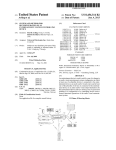


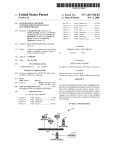

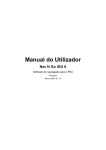
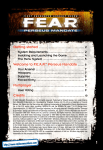
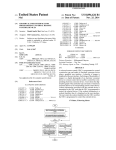
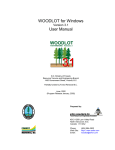

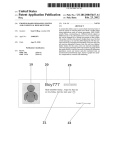
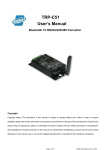
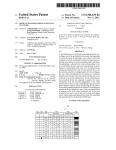
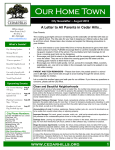
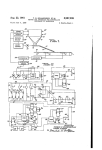
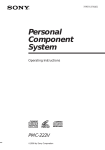
![[en] - User manual, [de] - Betriebshandbuch, [fr]](http://vs1.manualzilla.com/store/data/005845053_1-6d1995608e49c7f1600fcad0c20a630a-150x150.png)
